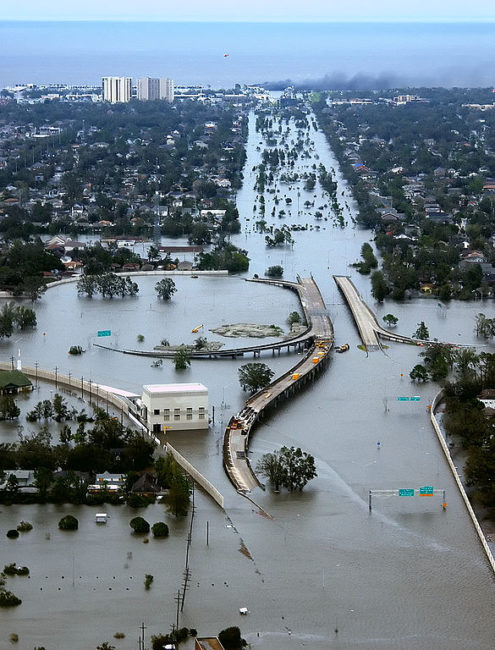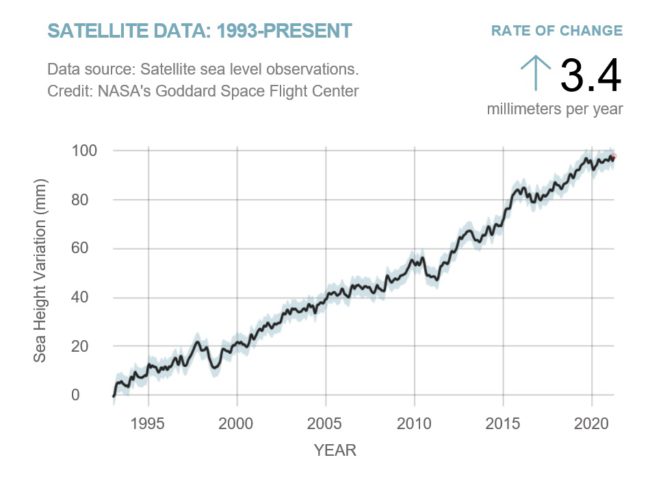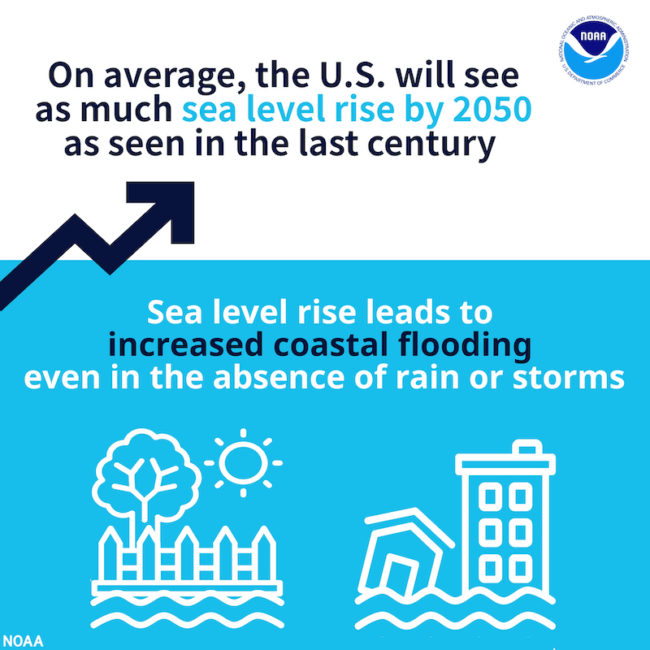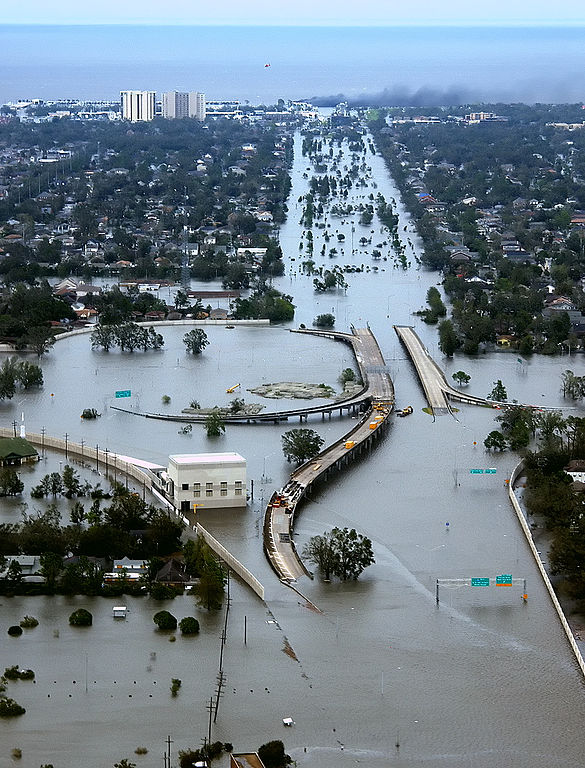
Sea level is rising. This is a well-established fact. The rate at which sea level is rising is also accelerating.
Between 1901 and 2018 sea level has risen by 6-10 in. That insight comes via tide gauges. It sounds like a simple measurement, but working that out is deeply complex. Land itself rises and falls, so you also need to account for that.
To help, we also have Satellite observations and that is far more accurate. Here is a quick chart of all the satellite data …

Why is this happening?
There is of course the obvious melting of ice in a warming world. However, most of the extra heat via global warming ends up being absorbed by oceans. If you warm water, it expands, and so this thermal expansion is also a big part of the cause of sea level rise.
NOAA has a new report.
They have projections going right out to 2150 and it is not good news. Their latest Sea Level Rise Technical Report provides the most up-to-date projections.
The key headline has been this …

You would perhaps like a specific number, so here in it. On average sea levels along the coastline will rise an additional 10-12 inches by 2050.
Why this timescale, sea level rise will not just stop in 2050. It will keep rising and get a lot worse?
Well because it ceases to be something really bad further down the line that we can ignore, which it will be. Instead it is something rather bad now in our lifetime. Those who also make plans and decisions for costal communities and cities need to start planning for what is coming soon.
Also, they have a high degree of confidence in the projections out to 2050.
There are however some weird differences.
Galveston, Texas will see a rise of 25 inches by 2060. When you suck large volumes of water and oil out of the ground, the land sinks, hence relative to a rising sea level, you get a bigger rise.
Meanwhile the Northwest coast will only experience a rise of 4 to 6 inches. The land is slowly rising. During the last ice age, vast amounts of ice pressed down on the land. Once all that was gone the land then slowly rises and that is still an ongoing process, hence the illusion of a lower sea level rise.
What are the key messages from this latest report?
There are four.
Point 1 – Regardless of what we do about Global Warming, they have a high degree of confidence that the data projections out to 2050 are correct – Sea level along the U.S. coastline is projected to rise, on average, 10 – 12 inches, and there is nothing we can do to prevent that.
Point 2 – Storm surges will become a far bigger issue because of the rise in sea level.
- Disruptive high tides (0.55 m above Mean Higher High Water [MHHW]) are currently an average of three per year. By 2050 there will be greater than ten events per year.
- Damaging high tides (about 0.85 m above MHHW) are currently an average of 0.3 a year. By 2050, there will be 4 events per year.
- Destructive high tides (about 1.20 m above MHHW) are currently an average of 0.04 a year. By 2050 there will be 0.2 events per year.
Point 3 – Beyond 2050 things the projections become fuzzy. Higher temperatures mean higher sea level. The ranges are 0.6–2.2 m in 2100 and 0.8–3.9 m in 2150. The uncertainty is down to us and what we do about global warming.
- Yes, the “m” there is “meters”. In the worst case pathway we get 3.9 meters of sea level rise by 2150. Envision in your mind the number of costal cities below that.
Point 4 – Monitoring the sources of ongoing sea level rise and the processes driving changes in sea level is critical
- Understanding what is coming and when enables us to trigger adaptive management plans
There is obviously a great deal more detail within the report. However, if you grasp the above four points then you have captured the core essence of it all.
Impact
Don’t let the data fool you into a false sense of security.
Tens of millions of people in the U.S. and hundreds of millions globally live in areas that are at risk of coastal flooding. Sea level rise does not act alone — rising sea levels, along with sinking lands, will combine with other coastal flood factors like storm surge, wave effects, river flows, and heavy rains to significantly increase the exposure of coastal communities, ecosystems, and economies. Sea level rise threatens infrastructure necessary for local jobs, regional industries, and public safety, such as roads, subways, drinking water supplies, power plants, oil and gas wells, and sewage treatment systems.
High-tide flooding events that occur only a few times a year now may occur once a month, or once a week in the coming decades. These same water level changes may also increase coastal erosion and groundwater levels.
Higher water levels also mean deadly and destructive storm surges.
Where can I find details of what will happen within my community?
Below is a list of various tools that help to Visualise this latest data location by location …
- Visualize community-level impacts from sea level rise and coastal flooding on NOAA’s Digital Coast Sea Level Rise Viewer.
- Visualize the updated scenarios and the new extrapolated observations data, as well as download the data, for global, regional, or individual tide gauges on NASA’s Sea Level Change Portal.
- Generate reports with current and future flooding impacts on stormwater systems with NOAA’s Adapting Stormwater Management for Coastal Floodstool.
- View accessible charts and graphs with sea level rise data for a specific coastal county on NOAA’s Coastal County Snapshot tool.
- Access and download sea level rise observation data, trends and projections at specific tide gauges on NOAA’s Sea Level Rise API URL Builder.
- Download three datasets – Scenarios of Future Mean Sea Level (2000 – 2150), Extreme Water Levels: Tide Gauges, and Extreme Water Levels: Gridded – from the 2022 technical report data and tools page.
Report Commentary
Let’s leave the final words on this to a few movers and shakers who are close to it all …
“For businesses along the coast, knowing what to expect and how to plan for the future is critical, These updated projections will help businesses, and the communities they support, understand risks and make smart investments in the years ahead.”
U.S. Secretary of Commerce Gina M. Raimondo
“This new data on sea rise is the latest reconfirmation that our climate crisis — as the President has said — is blinking ‘code red,’ We must redouble our efforts to cut the greenhouse gases that cause climate change while, at the same time, help our coastal communities become more resilient in the face of rising seas.”
Gina McCarthy, National Climate Advisor
“This is a global wake-up call and gives Americans the information needed to act now to best position ourselves for the future, As we build a Climate Ready Nation, these updated data can inform coastal communities and others about current and future vulnerabilities in the face of climate change and help them make smart decisions to keep people and property safe over the long run.”
Rick Spinrad, Ph.D., NOAA Administrator
“By 2050, moderate flooding — which is typically disruptive and damaging by today’s weather, sea level and infrastructure standards — is expected to occur more than 10 times as often as it does today, These numbers mean a change from a single event every 2-5 years to multiple events each year, in some places.”
Nicole LeBoeuf, NOAA National Ocean Service Director
“This report supports previous studies and confirms what we have long known: Sea levels are continuing to rise at an alarming rate, endangering communities around the world. Science is indisputable and urgent action is required to mitigate a climate crisis that is well underway, NASA is steadfast in our commitment to protecting our home planet by expanding our monitoring capabilities and continuing to ensure our climate data is not only accessible but understandable.”
Bill Nelson, NASA Administrator
